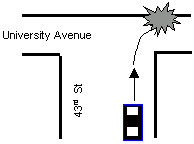Learning About Cyclones |
Home | <PREV | NEXT > |
:: Section 3
Principle Mechanism: Impaction
A cyclone uses centrifugal force to separate particles from a gas stream. The operation is similar to that of an impactor. Figure 1 shows the schematic of an impaction plate. The gas stream passes through a narrow nozzle at a high speed. When an obstacle (i.e. impaction plate in this case) is in front of the stream, the stream can easily make a turn to avoid the obstacle. Particles in the stream however, may have a different fate. Larger particles, due to their higher inertia, won't be able to follow the gas stream well, and therefore they will deviate from the gas stream, and they will impact on the plate.
Figure 1: The schematics of an impaction nozzle and an impaction plate.
Impaction, as can be seen, is the mechanism for the collection in the system, and it is more effective for larger particles. The most important parameter that affects impaction is called Stokes number (Stk). Stk includes both flow velocity and particle diameter and is defined as:
|
ρp = particle density |
| In a T-intersection, the traffic accident rate is higher if a turning vehicle cannot make a successful one. Using the analogy of impaction, evaluate how the following parameters affect the traffic accident rate: (a) vehicle size; (b) vehicle speed; (c) lane width. |  |
 where
where